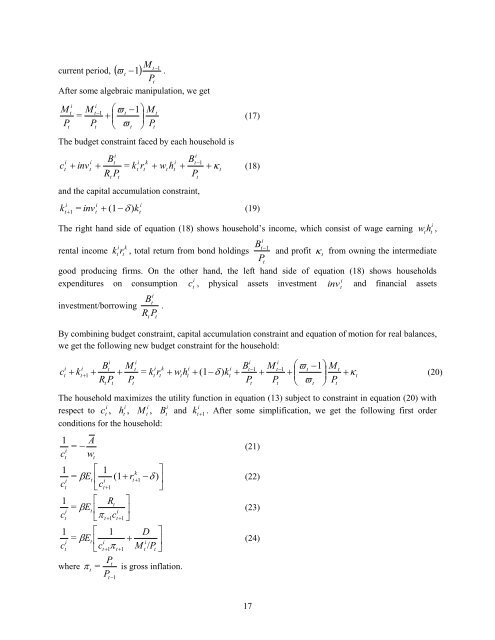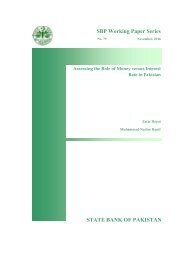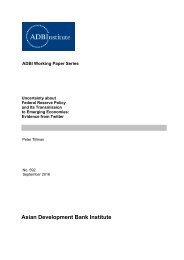SBP Working Paper Series STATE BANK OF PAKISTAN
n?u=RePEc:sbp:wpaper:74&r=mon
n?u=RePEc:sbp:wpaper:74&r=mon
You also want an ePaper? Increase the reach of your titles
YUMPU automatically turns print PDFs into web optimized ePapers that Google loves.
M 1<br />
t<br />
current period, t<br />
1 .<br />
Pt<br />
After some algebraic manipulation, we get<br />
M<br />
P<br />
i i<br />
t<br />
=<br />
t1<br />
t<br />
M<br />
P<br />
t<br />
t<br />
1<br />
M<br />
<br />
<br />
<br />
<br />
t Pt<br />
The budget constraint faced by each household is<br />
c<br />
i<br />
t<br />
inv<br />
i<br />
t<br />
t<br />
t<br />
t<br />
t<br />
(17)<br />
i<br />
i<br />
Bt<br />
i k i Bt<br />
1<br />
= kt<br />
rt<br />
wt<br />
ht<br />
<br />
t<br />
(18)<br />
R P<br />
P<br />
and the capital accumulation constraint,<br />
i i<br />
i<br />
k<br />
t 1<br />
= inv<br />
t<br />
(1<br />
) kt<br />
(19)<br />
The right hand side of equation (18) shows household’s income, which consist of wage earning<br />
rental income<br />
i<br />
k i<br />
r k<br />
, total return from bond holdings Bt<br />
1<br />
t t<br />
Pt<br />
w h i<br />
, t t<br />
<br />
and profit <br />
t<br />
from owning the intermediate<br />
good producing firms. On the other hand, the left hand side of equation (18) shows households<br />
i<br />
i<br />
expenditures on consumption c<br />
t<br />
, physical assets investment inv<br />
t<br />
and financial assets<br />
i<br />
B<br />
t<br />
investment/borrowing .<br />
R P<br />
t<br />
t<br />
By combining budget constraint, capital accumulation constraint and equation of motion for real balances,<br />
we get the following new budget constraint for the household:<br />
c k<br />
i<br />
t<br />
B<br />
M<br />
B<br />
<br />
1<br />
M<br />
i i<br />
i i<br />
i t t i k i<br />
i t1<br />
t1<br />
t<br />
t<br />
t<br />
kt<br />
rt<br />
wt<br />
ht<br />
<br />
kt<br />
<br />
t<br />
Rt<br />
Pt<br />
Pt<br />
Pt<br />
P<br />
<br />
t<br />
<br />
<br />
1 = (1 )<br />
(20)<br />
t<br />
Pt<br />
The household maximizes the utility function in equation (13) subject to constraint in equation (20) with<br />
i i i i<br />
i<br />
respect to c<br />
t<br />
, h<br />
t<br />
, M<br />
t<br />
, B<br />
t<br />
and kt<br />
1<br />
. After some simplification, we get the following first order<br />
conditions for the household:<br />
1<br />
= <br />
c<br />
i<br />
t<br />
A<br />
w<br />
t<br />
(21)<br />
1 1 k<br />
<br />
= Et<br />
(1 r 1<br />
<br />
)<br />
i<br />
i t <br />
ct<br />
ct<br />
1<br />
<br />
(22)<br />
1 R <br />
t<br />
= E<br />
i t i <br />
ct<br />
<br />
t1ct<br />
1<br />
<br />
(23)<br />
1 1 D <br />
= E <br />
i t i<br />
i <br />
c<br />
t ct<br />
1<br />
t1<br />
M<br />
t<br />
/ Pt<br />
<br />
(24)<br />
Pt<br />
where <br />
t<br />
=<br />
P<br />
is gross inflation.<br />
t1<br />
M<br />
<br />
<br />
17






